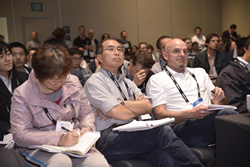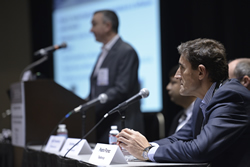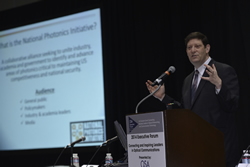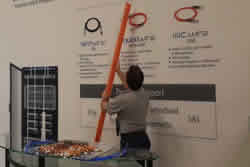PRESS RELEASE
11 March 2014
Day 2: Monday, March 10 Technical Sessions Begin as the Optical Communications Community Descends upon San Francisco
11 parallel sessions. 14 conference tracks. 115 invited presentations. 133 posters. 600 contributed papers. The sheer volume of work presented at OFC is more than a single attendee can digest at once—though many will try! Technical sessions began today and cover every topic of importance to the research community - from network architecture to multimode fibers to 1 Tb/s and beyond networks.
For example, an international team of researchers presented at OFC today about an algorithm that keeps data safe by moving or copying the data from data centers in peril to more secure locations away from the disaster. The algorithm assesses the risks for damage and users' demands on the network to determine, in real-time, which locations would provide the safest refuge from a disaster.
"Our content placement solution can be implemented with some modifications on any existing settings of data centers and it is adaptable to different dynamic disaster scenarios," said researcher Sifat Ferdousi of UC Davis. "This can highly benefit the network providers in designing disaster-resilient cloud networks."
Another session covered the latest in quadrature amplitude modulation (QAM). Attendees heard a report on advanced digital signal processing (DSP) that enables higher order QAM modulation (64QAM or higher). Presenters covered how digital nonlinearity compensation can also be adopted to help channel equalization in high order QAM modulated systems.
Other sessions included the latest technologies for SDM multiplexers. A team from Optoscribe presented the demonstration of coupler fabrication using laser inscription. The fabricated device has the benefit of being very compact one at roughly 4cm x 1cm x 1cm.
 Workshops continued with several more topics, including packaging of silicon photonics and its closely related topic of reliability and the commercial viability of single-fiber space-division multiplexing. The panel on the latter included experts from several leading telecom companies and service providers including Verizon, Google, and Alcatel-Lucent. All agreed that if the system and network components are available for SDM, and of course cost effective, SDM can be commercialized.
Workshops continued with several more topics, including packaging of silicon photonics and its closely related topic of reliability and the commercial viability of single-fiber space-division multiplexing. The panel on the latter included experts from several leading telecom companies and service providers including Verizon, Google, and Alcatel-Lucent. All agreed that if the system and network components are available for SDM, and of course cost effective, SDM can be commercialized.
Executives “Uncensored”
 Held every year in conjunction with OFC, the OSA Executive Forum features C-level panelists discussing the latest issues facing companies in the business – in an informal, uncensored setting. Topics included packet optical networks, silicon photonics and vertical integration; panelists represented British Telecom, IBM, Cisco and more.
Held every year in conjunction with OFC, the OSA Executive Forum features C-level panelists discussing the latest issues facing companies in the business – in an informal, uncensored setting. Topics included packet optical networks, silicon photonics and vertical integration; panelists represented British Telecom, IBM, Cisco and more.
Analyst Ed Zabitsky of ACI Research appreciated the global representation and honest nature of discussion that explored today’s challenges. “There’s great value in having two large European carriers at Exec Forum,” he said. “They spoke their minds on the lack of willingness of vendors to interoperate with one another, which is a serious limiting factor in moving the industry forward.”
In a town hall style discussion, Najam Ahmad, Director of Network Engineering at Facebook, talked about the need to extend optics “inside” the data center to a much longer distance. "We would ideally love to have a 2 kilometer solution," he said, noting Facebook's definition of a "data center" can now span, for example, four buildings on 10 or 20 acres of land. “Ideally this 2 kilometer span would be reached by a single pair of single-mode fiber,” he said. The problem with VCSEL-based technologies is that they require lots of parallel fibers, which are expensive.
Progress on the National Photonics Initiative
 OFC attendees have the opportunity to hear the latest status of the U.S. National Photonics Initiative (NPI) all week. Today at the OSA Executive Forum, Alan Willner of the University of Southern California reminded Executive Forum attendees that the NPI is an industry-wide effort to establish public-private partnerships in photonics, specifically in the areas of defense, energy, healthcare, communications and manufacturing. “Not one of these has a ‘photon’ in it,” he noted.
OFC attendees have the opportunity to hear the latest status of the U.S. National Photonics Initiative (NPI) all week. Today at the OSA Executive Forum, Alan Willner of the University of Southern California reminded Executive Forum attendees that the NPI is an industry-wide effort to establish public-private partnerships in photonics, specifically in the areas of defense, energy, healthcare, communications and manufacturing. “Not one of these has a ‘photon’ in it,” he noted.
He also briefed the group about a proposed National Photonics Prototyping Facility. “The point of photonics prototyping is to enable innovation, not pick a winner.”
He concluded that raising the importance of photonics as an enabling technology is important globally, not just in the United States. “I was shocked by the intense support from outside the U.S. to see NPI succeed,” Willner said. OIDA will also hold a session on the NPI tomorrow on the show floor. For more on the communications and IT recommendations of the NPI, visit the NPI website.
Exhibit Hall Taking Shape
 Exhibitors were putting the final touches on their booths for the opening of the show floor tomorrow morning. Simon Cai of GoPhoton! is excited about the location this year and looking forward to creating some buzz. “We have some new products that we’ll be unveiling this week. We are looking forward to great industry turnout and are ready for a busy, successful show,” he said. His company is one of 550 that will be on-site this week. Many are already announcing their new products and show floor news in the Exhibitor News section of the OFC website.
Exhibitors were putting the final touches on their booths for the opening of the show floor tomorrow morning. Simon Cai of GoPhoton! is excited about the location this year and looking forward to creating some buzz. “We have some new products that we’ll be unveiling this week. We are looking forward to great industry turnout and are ready for a busy, successful show,” he said. His company is one of 550 that will be on-site this week. Many are already announcing their new products and show floor news in the Exhibitor News section of the OFC website.